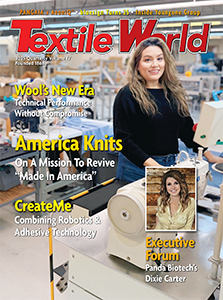T
he nonwovens industry makes use of a wide range of textile fibers. Functional properties
may be inherent or engineered into both natural and man-made fibers to make them appropriate for
various applications. This article highlights a few well-established fibers as well as some newer
fiber entries into the nonwovens marketplace and mentions the manufacturing processes used.
Natural And Renewable Fibers
In consideration of the increasing demand for ever-more environmentally sustainable products
and processes, natural and biobased fibers are good choices for certain nonwoven products because
they are biodegradable and compostable as well as being produced from renewable resources. And
while recycling generally is a consideration related to the sustainability of man-made fibers,
natural- and renewable-fiber-based materials also can be recycled for certain nonwoven
applications.
Cotton
Cotton is used in nonwoven hygiene products including wipes, feminine hygiene products,
diapers and adult incontinence products. It is soft, comfortable, hypoallergenic and naturally
absorbent; and has greater wet strength than dry. Most hygiene products are spunlaced; but cotton
also may be needlepunched for wipes such as decontamination wipes, and also in its relatively
unprocessed raw state for oil absorption, such as cotton boom used in the recent Gulf of Mexico oil
spill cleanup efforts.
“With respect to nonwoven fibers, cotton is a recent trend and is continuing to grow at a
surprisingly healthy rate,” said Janet Regan, director of strategic initiatives, Cotton
Incorporated, Cary, N.C., a marketing and R&D company promoting upland cotton. She listed
several reasons including the aforementioned trend toward sustainability; the growth of the wipes
market over the last 10 years; the development and growth of spunlacing technology; pricing;
performance and consumer appeal; and health- and well-being-related features, especially for
hygiene applications.
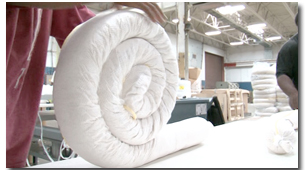
Needlepunched cotton boom such as this manufactured by Milwaukee-based Sellars
Absorbent Materials Inc. — made from relatively unprocessed, naturally oleophilic and hydrophobic
raw cotton — has been used to soak up oil in the Gulf of Mexico following the explosion and
sinking of the BP Deepwater Horizon oil rig in April 2010.
Regan went on to talk about the needlepunched oil-absorbing cotton boom that played a role
in the Gulf cleanup. “This is a really cool newer direction,” she said. “Bleached and scoured
cotton took off for wipes and hygiene, but over past two years, we’ve also been working with raw
fiber that hasn’t been processed except for mechanical cleaning. That fiber is naturally oleophilic
and hydrophobic. It’s Mother Nature’s way of preventing the fiber from biodegrading in the field
while it’s growing because it has oils and pectins on it that protect it from the elements.”
Viscose And Lyocell
Regenerated cellulosic fibers such as viscose and lyocell also have nonwoven hygiene, wipes
and incontinence applications, for virtually the same reasons that make cotton suitable for those
uses, but also because their production conditions are not conducive for microbial growth — an
advantage as well for many other applications. Technical applications include electrical
insulation, automotive and filtration; as well as medical drapes, swabs and wound dressings.
Nonwoven processes used include spunlace, needlepunch and chemical bonding.
Austria-based Lenzing AG offers Lenzing Viscose® — whose production technology includes the
recycling or sale of the chemical and waste products produced in the process — and Tencel® and
Lenzing Lyocell® — both produced in a closed-loop process that uses no harmful chemicals — for
various nonwoven applications noted above. The company reports it can customize the fiber to suit a
particular application — for example, by adding a finish to facilitate high-speed carding,
improving the absorbency for a feminine hygiene product, or enhancing the purity of fiber used in
electrical insulation products.

Lenzing Viscose®, Tencel® and Lenzing Lyocell® are 100-percent biodegradable as well as
soft, hypoallergenic and naturally absorbent, making them appropriate fibers for use in personal
care products such as the wet wipe shown above. Photograph courtesy of Lenzing AG/Marcus
Renner
In the filtration arena, Lenzing Viscose has long been used in food and beverage
applications; while Tencel, with its tendency to fibrillate, is being promoted for automotive fuel
and oil filters, cigarette filters, and industrial air and liquid process filters. Lenzing reports
Tencel’s properties include significantly increased wet strength and low linting in addition to the
absorbency, softness and breathability that are inherent in both Lenzing Viscose and Tencel. The
company also notes that its customized Tencel Short Cut fibers offer a flushable solution for
wipes, and its Tencel Tow can be cut and converted by downstream users for various specialty
products and applications.
Viscose, Tencel and lyocell are spunlaced for hygiene, wipes and other personal care
products, as well as for gauzes and face masks. They may be blended with polyamide or polyester
into spunlaced coating substrates, such as for artificial leather. Low-linting lyocell and Tencel
also can be used for clean room wipes. Needlepunched viscose, Tencel and lyocell, alone or in
blends, have applications in hygiene and medical products, wipes, coating substrates and artificial
leather. Chemical bonding applications include medical drape, food contact, interlining and
household wipes. Lenzing reports chemically bonded nonwovens made with Tencel and Lenzing Lyocell
can offer added strength or lighter weight; and when binder levels are reduced, they can offer
increased absorbency.
Polylactide
Polylactide (PLA) biopolymers offer a renewable and biodegradable or recyclable alternative
to petrochemical-based fibers. Applications include spunlaced wipes and hygiene products, in which
PLA may be blended with cotton or viscose; agricultural textiles that may be tilled under at the
end of a growing season; needlepunched carpet and automotive products; spunbond filtration and
geotextile products as well as teabags and other such products; and meltblown filtration products.
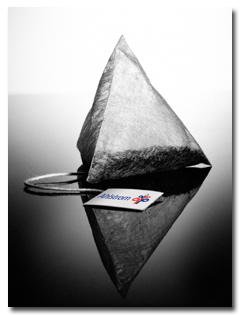
Finland-based Ahlstrom Corp. has designed this unique tea bag using spunbond Ingeo™
polylactide fiber.
NatureWorks LLC, Minnetonka, Minn., produces PLA under the Ingeo™ brand. According to Robert
Green, the company’s Americas director, Fibers and Nonwovens, the fiber offers opportunities to
meet market needs and is competitive price-wise with incumbent fibers.
“We think that, in general, the hygiene space is a very good fit for our materials. A lot of
wipes already have natural components, such as viscose and cotton, and Ingeo is a great complement.
Essentially, it offers a thermoplastic that has natural origins and very good environmental
credentials,” Green said, adding that using Ingeo in a blend with cotton or viscose allows
producers to improve the sustainability of their products.
PLA also has inherent flammability characteristics, Green noted. It is difficult to start
burning and generates little smoke, he said; and its self-extinguish time is significantly shorter
than polyester or cotton. It also is inherently ultraviolet-transparent, moisture-wicking and
hypoallergenic; and has low odor retention. These properties can be further improved using topical
treatments or additives.
Man-made Fibers
Man-made fibers are used in many of the same applications as natural and renewable fibers,
and sometimes are blended with those fibers to provide enhanced function in a product.
Polyester
Polyester staple fiber (PSF) has applications in spunlaced products including wipes and
hygiene as well as medical/surgical gowns, masks, drapes and such; needlepunched filtration,
automotive and industrial products; airlaid filtration products; and resin bond and thermal bond
products. There is also significant growth in spunbond applications using polyester resin. Specific
functionalities, such as antimicrobial properties for filtration applications or moisture
management for wipes, can be integrated into the polymer.
According to Wayne Proctor, senior manager of sales, nonwovens, for Charlotte-based PSF
manufacturer DAK Americas LLC, spunlace comprises the biggest part of the nonwovens market where
polyester is concerned. “DAK’s key to success in this market is that it is dedicated to fiber
design to deliver functionality,” he said. “For example, we design the proper crimp, finish or heat
set that delivers the functionality the customer desires, depending on the intended application.”
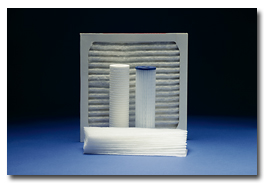
Filtration products may be may be made from a range of both petrochemical-based and biobased
fibers.
In addition, DAK Americas’ Steripur®AM silver-based antimicrobial fiber has filtration
applications, and Delcron® Hydrotec moisture-management fiber has applications in wipes and also
some filtration. These functionalities are integrated permanently into the fiber rather than
applied as topical treatments, said Ricky Lane, the company’s manager, public affairs, trade
relations and communications.
Polypropylene And Bicomponent Fibers
Polypropylene (PP) is used in diaper, baby wipe, filtration, automotive, geosynthetics,
furniture backing, construction, insulation and acoustics applications, among others. Because of
its low specific gravity, it may replace other fibers to reduce basis weight and system cost; but
modifying the fiber’s surface may also provide alternatives to replace other PP fibers in certain
applications, according to John Wolhar, hygiene sales manager, Americas, for Duluth, Ga.-based
polyolefin fiber manufacturer FiberVisions Corp. Nonwoven processes used include spunlace, carded
thermal bond, needlepunch and spunbond.
Wohlar said PP doesn’t necessarily compete with other fibers in the nonwovens arena. “We’re
competing with alternate technologies or other forms of PP, offering finer fibers, shapes or
modified surface characteristics like finish that allow people to use a staple-based nonwoven to
replace a spunbond nonwoven, for example,” he explained. The fibers can be treated to make them
hydrophilic or hydrophobic. Wohlar also mentioned botanical finishes — such as chamomile, green
tea and aloe — and vitamin E, noting they may offer benefits in certain applications.
FiberVisions recently has introduced fine-titer shaped polyolefin fibers for nonwovens
markets. The company reports these fibers can improve fabric uniformity, coverage and fabric
opacity; and also provide loft and enhanced softness.
Bicomponent fibers also may be used in nonwoven applications. FiberVisions’ sister company
ES FiberVisions manufactures bicomponent fibers for hygiene, cosmetics, filtration, medical,
industrial and agricultural applications. These might be biodegradable, or have a PP or polyester
core and a PP or polyethylene sheath; or they may be based on specialized polymers. They often are
used in low-level blends to bind other fibers. Processes include thermal bond, carded through air,
airlaid, wetlaid, carded needlepunch and carded spunlace. Teabags and wipes are two wetlaid
applications using short cut fibers. Airlaid nonwovens using bicomponent fibers are used primarily
for baby wet wipes, industrial oil absorbent pads and feminine hygiene product components.
Recycled Fibers
Post-industrial and post-consumer recycled fiber also is used in nonwoven products and
provides the added advantage of giving textile waste another life instead of having it end up in a
landfill.
Leigh Fibers Inc., Wellford, S.C., reprocesses post-industrial fabric waste made with both
natural and man-made fibers into shoddy for use in a wide range of nonwoven and other
under-the-surface applications as well as for remelting and spinning applications. The company’s
SafeLeigh™ flame-retardant (FR) aramid fiber recycled from post-industrial clippings can provide
inherent FR properties for needlepunched and airlaid nonwoven furniture, mattress and automotive
applications, according to George Martin, the company’s executive vice president of sales and
marketing. Denim may be turned into carpet pads or insulation. Cotton, rayon, acetate, PP, acrylic
and other textile waste can be used in many under-the-surface applications as well as wet wipes.
Besides needlepunch, processes include airlaid, thermal bond, garnetting and other pad-making
processes.
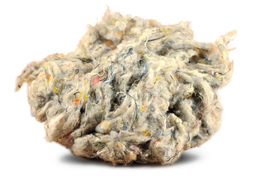
Leigh Fibers’ SafeLeigh™ FR aramid fiber offers inherent FR properties for needlepunched
and airlaid nonwoven furniture, mattress and automotive applications.
Cotton Incorporated’s Regan also mentioned initiatives for recycling post-industrial and
post-consumer cotton textiles. Strateline Industries LLC, Rogers, Ark., makes wet wipe substrates
from fiber recycled from fabric cuttings supplied by T-shirt factories in China. In another
project, Cotton Incorporated has partnered with Bonded Logic Inc., Chandler, Ariz., to collect blue
jeans for reprocessing into insulation that is donated for use in houses built by Habitat for
Humanity. The insulation and other building products made using reprocessed post-industrial cotton
and other cellulose materials also are available through retail channels.
Post-consumer recycled fibers such as PLA or polyester can be used in any application —
nonwoven or other — that uses virgin fiber.
While PLA is biodegradable and can be composted, it also can be recycled in a closed-loop
system, as was the needlepunched carpet made with Ingeo fibers that was installed at the site of
the United Nations Climate Change Conference, held in December 2009 in Copenhagen, Denmark.
“At the end of its useful life, PLA can be hydrolized back to lactic acid very easily and
economically,” NatureWorks’ Green said. “This chemical recycling potentially will alleviate issues
of cleaning and contamination.”
DAK Americas has partnered with Dalton, Ga.-based carpet manufacturer Shaw Industries Inc.
to establish a joint venture in Fayetteville, N.C. — Clear Path Recycling LLC — to recycle
post-consumer polyethylene terephthalate (PET) bottles into Recycled PET (RPET) flake of a high and
consistent quality that will be used by both companies to process into fiber.
“We now have the foundation to include recycled content in our product and will strive to
meet our customers’ requirements to incorporate the product into endstream uses,” DAK Americas’
Lane said. The fiber will be available for all applicable end-uses including nonwovens.
September/October 2010

